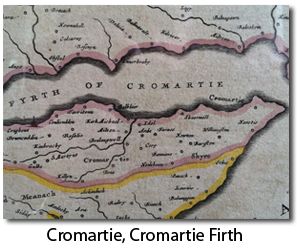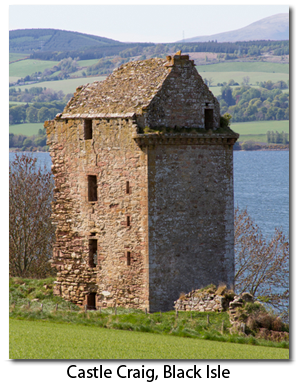Urquharts of Cromartie
 CROMARTIE- FIRST AND PRINCIPAL FAMILY OF URQUHART.
CROMARTIE- FIRST AND PRINCIPAL FAMILY OF URQUHART.
"The surname of Urquhart is of great antiquity," wrote Alexander Nisbet in 1722, "and the family of Cromartie" was always esteemed the first and principal family of that name.
In comparison with other clans, its numbers were perhaps few, but the Urquharts of Cromartie had power as Hereditary Sheriffs of Cromartie, and possessing lands in Ross, Inverness-shire, Moray, Buchan and Aberdeenshire; on the Black Isle; and along the southern plain of the Moray Firth from the approaches to Castle Urquhart in the west to Urquhart-On-Spey in the east.
Any history of Urquhart lands or family would not be complete without discussion of one of it's most colorful sons, Sir Thomas Urquhart of Cromartie. "Sir Thomas" was born in 1611 to the old landholding family of Cromartie on the Black Isle. At the age of eleven he attended King's College, University of Aberdeen. Afterwards he toured the Continent, returning in 1636. In 1639, he participated in the Royalist uprising known as the Trot of Turriff; he was knighted by Charles I at Whitehall for his support. In 1641 he published his first book, a volume of epigrams.
Urquhart's father died in 1642, leaving behind a large estate encumbered by larger debts. As the eldest son, Urquhart was from that time on harassed by creditors. He left for the Continent in order to economize, but returned in 1645 and published Trissotetras, a mathematical treatise.
In 1648, Urquhart participated in the Royalist uprising at Inverness. He was declared a traitor by Parliament, though he doesn't seem to have suffered any other consequences.
 Two years later he marched with Charles II and fought in the Battle of Worcester. The Royalist forces were decisively defeated and Urquhart was taken prisoner. He lost all his manuscripts, which he had brought with him for safekeeping, and he had to forfeit all his property. He was held first at the Tower of London and later at Windsor, but he was given considerable freedom by his captors. The following year he published Pantochronachanon, a work of genealogy, and The Jewel, a defense of Scotland. In 1652, he was paroled by Cromwell and returned to his Cromartie lands. Soon after he published Logopandecteision, his plan for a universal language, and his most celebrated work, his translation of Rabelais.
Two years later he marched with Charles II and fought in the Battle of Worcester. The Royalist forces were decisively defeated and Urquhart was taken prisoner. He lost all his manuscripts, which he had brought with him for safekeeping, and he had to forfeit all his property. He was held first at the Tower of London and later at Windsor, but he was given considerable freedom by his captors. The following year he published Pantochronachanon, a work of genealogy, and The Jewel, a defense of Scotland. In 1652, he was paroled by Cromwell and returned to his Cromartie lands. Soon after he published Logopandecteision, his plan for a universal language, and his most celebrated work, his translation of Rabelais.
Urquhart returned to the Continent some time after 1653, perhaps as a condition of his release by Cromwell. Little is known of his life after this time. He died no later than 1660, because in that year his younger brother took up his hereditary titles. There is a legend that Urquhart died in a fit of laughter on receiving news of the Restoration of Charles II.
 Castle Craig is a 16th-Century fortified tower, perched on a rocky outcrop, on the shores of the Cromarty Firth. Naturally protected on three sides by steep drops to the shore, the tower would have originally been fortified on its landward side by battlements and round towers. The four-story tower contains gun-loops (openings for cannons), fashionable at the time it was built.
The tower has vaulted floors which still survive and there are the remains of a large fireplace on the ground floor. A wing probably extended to the northwest but this has fallen to ruin.
Castle Craig was probably built for the Urquharts of Cromartie. They held the hereditary sherrifdom of Cromartie and Craig Castle marks the western boundary of that sherrifdom. Nearby Cullicudden Burial Ground contains a burial enclosure of this Urquhart family. Other fortified houses on the Black Isle belonging to the Urquharts included Kinbeachie Castle and Cromartie Castle but very little of these buildings remain today.
Castle Craig is a 16th-Century fortified tower, perched on a rocky outcrop, on the shores of the Cromarty Firth. Naturally protected on three sides by steep drops to the shore, the tower would have originally been fortified on its landward side by battlements and round towers. The four-story tower contains gun-loops (openings for cannons), fashionable at the time it was built.
The tower has vaulted floors which still survive and there are the remains of a large fireplace on the ground floor. A wing probably extended to the northwest but this has fallen to ruin.
Castle Craig was probably built for the Urquharts of Cromartie. They held the hereditary sherrifdom of Cromartie and Craig Castle marks the western boundary of that sherrifdom. Nearby Cullicudden Burial Ground contains a burial enclosure of this Urquhart family. Other fortified houses on the Black Isle belonging to the Urquharts included Kinbeachie Castle and Cromartie Castle but very little of these buildings remain today. In the post-Reformation period, Craig Castle later became associated with the Bishops of Ross who may have used it as a place of summer residence. It eventually came into the ownership of the Newhall Estate who subsequently gifted it to the hereditary chief of Clan Urquhart in 1959. The Black Isle Charitable Corporation For Castle Craig's Preservation And Restoration is a Scottish Charity formed to promote interest in, and raise funds to finance, the restoration of Castle Craig for future Clan Urquhart generations.

